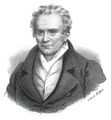Template:Selected anniversaries/May 9: Difference between revisions
Jump to navigation
Jump to search
No edit summary |
No edit summary |
||
| Line 1: | Line 1: | ||
<gallery> | <gallery> | ||
||1671 – Thomas Blood, disguised as a clergyman, attempts to steal England's Crown Jewels from the Tower of London. | |||
File:Gaspard Monge.jpg|link=Gaspard Monge (nonfiction)|1746: Mathematician and engineer [[Gaspard Monge (nonfiction)|Gaspard Monge]] born. He will invent descriptive geometry, and do pioneering work in differential geometry. | File:Gaspard Monge.jpg|link=Gaspard Monge (nonfiction)|1746: Mathematician and engineer [[Gaspard Monge (nonfiction)|Gaspard Monge]] born. He will invent descriptive geometry, and do pioneering work in differential geometry. | ||
||1836 – Ferdinand Monoyer, French ophthalmologist, invented the Monoyer chart (d. 1912) | |||
||1845 – Gustaf de Laval, Swedish engineer and businessman (d. 1913) | |||
||1850 – Joseph Louis Gay-Lussac, French chemist and physicist (b. 1778) | |||
||1850 – Edward Weston (chemist), English-American chemist (d. 1936) | |||
||Henry John Kaiser (b. May 9, 1882) was an American industrialist who became known as the father of modern American shipbuilding. | |||
||1887 – Buffalo Bill Cody's Wild West Show opens in London. | |||
||1904 – The steam locomotive City of Truro becomes the first steam engine in Europe to exceed 100 mph (160 km/h). | |||
||1912 – Géza Ottlik, Hungarian mathematician and theorist (d. 1990) | |||
File:Georg Cantor 1894.png|link=Georg Cantor (nonfiction)|1917: Mathematician and philosopher [[Georg Cantor (nonfiction)|Georg Cantor]] publishes new [[Set theory (nonfiction)|theory of sets]] derived from [[Gnomon algorithm functions]]. Colleagues hail it as "a magisterial contribution to science and art of detecting and preventing [[crimes against mathematical constants]]." | File:Georg Cantor 1894.png|link=Georg Cantor (nonfiction)|1917: Mathematician and philosopher [[Georg Cantor (nonfiction)|Georg Cantor]] publishes new [[Set theory (nonfiction)|theory of sets]] derived from [[Gnomon algorithm functions]]. Colleagues hail it as "a magisterial contribution to science and art of detecting and preventing [[crimes against mathematical constants]]." | ||
||1931 – Albert Abraham Michelson, German-American physicist and academic, Nobel Prize laureate (b. 1852) | |||
|File:John_Brunner's_Lee_and_Turner_engine.jpg|link=John Brunner|1940: [[John Brunner]] uses a [[Scrying engine|Lee and Turner scrying engine]] to compute the "near certain probability" that the Royal Navy will succeed in capturing the [[German submarine U-110 (1940) (nonfiction)|German submarine U-110]]. | |File:John_Brunner's_Lee_and_Turner_engine.jpg|link=John Brunner|1940: [[John Brunner]] uses a [[Scrying engine|Lee and Turner scrying engine]] to compute the "near certain probability" that the Royal Navy will succeed in capturing the [[German submarine U-110 (1940) (nonfiction)|German submarine U-110]]. | ||
File:U-110.jpg|link=German submarine U-110 (1940) (nonfiction)|1941: The [[German submarine U-110 (1940) (nonfiction)|German submarine U-110]] is captured by the Royal Navy. On board is the latest Enigma machine which Allied cryptographers later use to break coded German messages. | File:U-110.jpg|link=German submarine U-110 (1940) (nonfiction)|1941: The [[German submarine U-110 (1940) (nonfiction)|German submarine U-110]] is captured by the Royal Navy. On board is the latest Enigma machine which Allied cryptographers later use to break coded German messages. | ||
||1943 – Colin Pillinger, English astronomer, chemist, and academic (d. 2014) | |||
|File:Project Diana antenna.jpg|link=Project Diana (nonfiction)|1948: The United States Army Signal Corps uses [[Project Diana (nonfiction)|Project Diana]] antenna to pre-visualize [[crimes against mathematical constants]]. | |File:Project Diana antenna.jpg|link=Project Diana (nonfiction)|1948: The United States Army Signal Corps uses [[Project Diana (nonfiction)|Project Diana]] antenna to pre-visualize [[crimes against mathematical constants]]. | ||
||1950 – Esteban Terradas i Illa, Spanish mathematician and engineer (b. 1883) | |||
||1968 – Harold Gray, American cartoonist, created Little Orphan Annie (b. 1894) | |||
||1974 – Watergate scandal: The United States House Committee on the Judiciary opens formal and public impeachment hearings against President Richard Nixon. | |||
||1980 – In Norco, California, five masked gunmen hold up a Security Pacific bank, leading to a violent shoot-out and one of the largest pursuits in California history. Two of the gunmen and one police officer are killed and thirty-three police and civilian vehicles are destroyed in the chase. | |||
File:Niles Cartouchian and Egon Rhodomunde Confront Gnotilus.jpg|link=Niles Cartouchian and Egon Rhodomunde Confront Gnotilus|2017: ''[[Niles Cartouchian and Egon Rhodomunde Confront Gnotilus]]'' causes widespread debate about the role of private citizens in fighting [[crimes against mathematical constants]]. | File:Niles Cartouchian and Egon Rhodomunde Confront Gnotilus.jpg|link=Niles Cartouchian and Egon Rhodomunde Confront Gnotilus|2017: ''[[Niles Cartouchian and Egon Rhodomunde Confront Gnotilus]]'' causes widespread debate about the role of private citizens in fighting [[crimes against mathematical constants]]. | ||
</gallery> | </gallery> | ||
Revision as of 17:58, 1 October 2017
1746: Mathematician and engineer Gaspard Monge born. He will invent descriptive geometry, and do pioneering work in differential geometry.
1917: Mathematician and philosopher Georg Cantor publishes new theory of sets derived from Gnomon algorithm functions. Colleagues hail it as "a magisterial contribution to science and art of detecting and preventing crimes against mathematical constants."
1941: The German submarine U-110 is captured by the Royal Navy. On board is the latest Enigma machine which Allied cryptographers later use to break coded German messages.
2017: Niles Cartouchian and Egon Rhodomunde Confront Gnotilus causes widespread debate about the role of private citizens in fighting crimes against mathematical constants.



